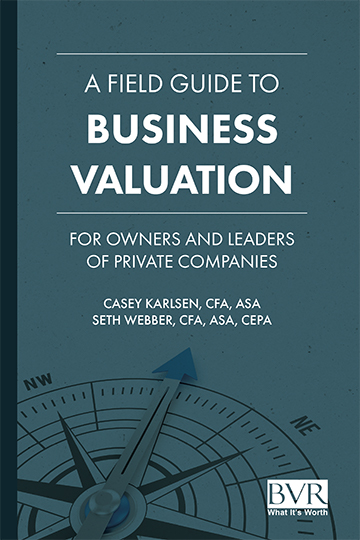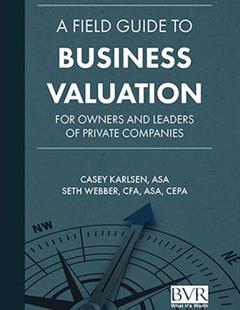A Field Guide to Business Valuation
September 2022 PDF, Softcover (219 pages)
Casey Karlsen, Seth Webber
Business Valuation Resources, LLC
The authors of this new book have translated their experience in the field into a usable and cohesive guide for business owners. Karlsen and Webber have extensive expertise helping business owners estimate, preserve, and increase business value – an audience typically without a background in business valuation. They employ simple analogies – all rooted in actual and numerous questions they have answered over the years – to help people understand complicated topics and are passionate about providing more people with a greater understanding of how businesses are valued.
It is an ideal first book for people who want to learn how to perform valuations themselves. It does not contain all the details necessary to master the craft of business valuation but will serve as an excellent introduction to the topic.
Part I: Introduction and Overview
Chapter 1: Introduction
Chapter 2: Course Walk-Through: Overview of Business Valuations
Course Walk-Through
Simplified Valuation Model
Chapter 3: Reasons for a Business Valuation
Part II: The Valuation Foundation
Conclusion
Chapter 5: Premise and Level of Value
Premise of Value
Level of Value
Conclusion
Chapter 6: Economic Overview and Industry Analysis
Economic Analysis
Industry Analysis
Conclusion
Chapter 7: Subject Company Description
Conclusion
Chapter 8: Financial Statement Analysis and Benchmarking
Financial Statement Analysis
Adjustments to Financial Statements
Trend Analysis
Common Size Analysis
Ratio Analysis
Profitability
Financial Leverage
Cost Structure
Additional Financial Metrics
Selecting Industry Benchmarks
Creating Industry Benchmarks
Compiled Industry Benchmarks
Conclusion
Part III: The Market Approach
Chapter 9: Overview of the Market Approach
Application of the Market Approach
Strengths
Weaknesses
Conclusion
Chapter 10: Guideline Completed Transaction Method Summary
Conclusion
Chapter 11: Guideline Public Company Method Summary
Conclusion
Chapter 12: Estimating an Appropriate Valuation Multiple
Historical EBITDA Multiples
Multiples by Industry
Factors Affecting Multiples
Conclusion
Part IV: The Income Approach
Income Approach Variables
Forecasted Income
Discount Rate
Application of the Income Approach
Capitalization of Earnings Method
Discounted Cash Flow Method
Direct Equity Models
Strengths
Weaknesses
Conclusion
Chapter 14: Forecasting: A Practical Guide
Top-Down Forecasting
Bottom-Up Forecasting
Practical Considerations
Benefits of Forecasting
Conclusion
Chapter 15: Estimating an Appropriate Discount Rate
Weighted Average Cost of Capital Formula
Weight of Debt and Equity
Cost of Debt
Cost of Equity
Risk Profile Factors to Consider
Illustrative Example
Conclusion
Chapter 16: A Bird’s-Eye View of the Buildup Model
Impact of Discount Rate Errors
Buildup Model Components
Risk-Free Rate
Equity Risk Premium
Industry Risk Premium
Size Premium
Company-Specific Risk Premium
Buildup Model Illustrative Example
Tips for Working With Valuation Analysts
Conclusion
Chapter 17: Additional Cost of Equity Capital Models
Buildup Model—Kroll Risk Premium Report (B Tables)
Buildup Model—Kroll Risk Premium Report (A Tables)
Modified Capital Asset Pricing Model Conclusion
Part V: The Asset Approach
Strengths and Weaknesses
Illustrative Example
Additional Considerations
Conclusion
Part VI: Arriving at a Concluded Value
Value Reconciliation
Conclusion
Chapter 20: Valuation Adjustments
Discount for Lack of Control
Discount for Lack of Marketability
Application of Discounts
Conclusion
Part VII: Additional Valuation Content
Additional Content
Chapter 22: Top 10 Errors in Business Valuations
Error No. 1—Biting Off More Than You Can Chew
Error No. 2—Inadequate Supporting Data
Error No. 3—Excessive Typographical Errors
Error No. 4—Incomplete Due Diligence
Error No. 5—Incomplete Financial Analysis
Error No. 6—Choosing an Inappropriate Method to Value the Subject Company
Error No. 7—Contradictions Between Valuation Methods
Error No. 8—Unrealistic Projections
Error No. 9—Confusing Enterprise Value and Equity Value
Error No. 10—Inadequately Supported Discounts for Lack of Control and/or Marketability
Conclusion
Chapter 23: Key Steps for Business Sale Preparation
Planning for the Exit Event
Increasing Business Value
Final Preparations
Conclusion
Chapter 24: Tips for Buying a Business
Recent M&A Activity
Tip No. 1: Avoid Being Rushed
Tip No. 2: Perform Rigorous Financial Due Diligence
Tip No 3: Analyze Key Relationships
Tip No. 4: Learn About the Employees
Tip No. 5: Assess Key-Person Dependence
Tip No. 6: Have the Seller Stick Around
Tip No. 7: Don’t Assume the Good Times Will Last Forever
Tip No. 8: Consider Tax and Legal Consequences
Tip No. 9: Get Different Perspectives
Conclusion

